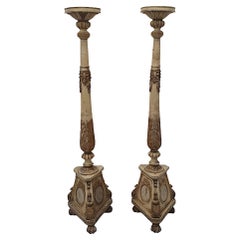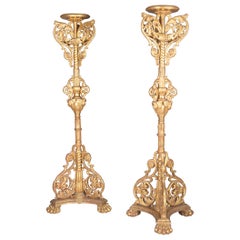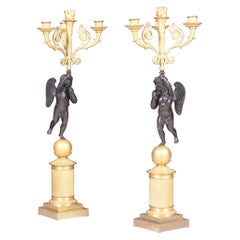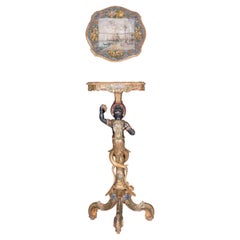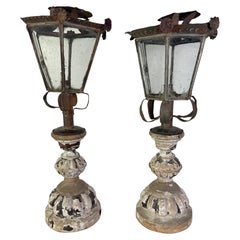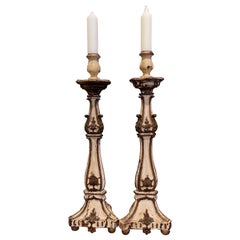Dublin Torchères
to
4
4
1
1
3
3
1
1
1
138
118
4
2
2
Height
to
Width
to
4
4
4
Item Ships From: Dublin
Very Rare and Unusual Pair of 19th Century Parcel Gilt Torcheres
Located in Dublin, IE
A very rare and unusual pair of 19th century hand painted and gilded torcheres in original condition, finely hand carved and adorned with beautiful mo...
Category
19th Century French Antique Dublin Torchères
Materials
Wood, Giltwood, Paint
Monumental Pair of 19th Century Baroque Style Italian Carved Giltwood Torcheres
Located in Dublin, IE
A magnificent monumental pair of Italian Baroque style carved giltwood torcheres, each comprising a circular dished top above an elaborately carved pillar with floral swags and gargo...
Category
19th Century Italian Baroque Antique Dublin Torchères
Materials
Giltwood
Pair of Early 19th Century French Ormolu & Bronze Empire Period Candelabra
Located in Dublin, IE
A stunning pair of early 19th century French Empire candelabra, with four scrolled candle arms supported by classical winged figu...
Category
Early 19th Century French Empire Antique Dublin Torchères
Materials
Bronze, Ormolu
19th Century Italian Venetian Gilded & Painted Gondolier Pedestal Table
Located in Dublin, IE
A good 19th century Venetian Italian Gondolier torchere stand, of typical Venetian form, polychrome painted with the softwood carved figure holding the shaped silvered top and a bunc...
Category
19th Century Italian Rococo Revival Antique Dublin Torchères
Materials
Giltwood
Related Items
Pair of 19th Century Italian Lanterns with Carved and Painted Bases
Located in Los Angeles, CA
This rare pair of late 19th-century Italian lanterns combines rustic ironwork with elegantly carved wooden bases, showcasing the charm of Southern European craftsmanship.
Each lante...
Category
19th Century Italian Baroque Antique Dublin Torchères
Materials
Walnut
$2,800 / set
H 23 in W 10 in D 10 in
Pair of 19th Century Italian Carved Two-Tone Painted Candlesticks
Located in Dallas, TX
Add an air of elegance to your home with this pair of antique candlesticks. Crafted in Italy circa 1880, each candle holder stands on round feet over a sturdy triangle base decorated...
Category
Late 19th Century Italian Louis XV Antique Dublin Torchères
Materials
Wood
$1,200 / set
H 22.5 in W 7 in D 7 in
Pair of 19th Century Empire Ormolu and patinated Bronze Candelabra attr. Thomire
By Pierre-Philippe Thomire
Located in Berlin, DE
Pair of 19th century Empire ormolu and patinated bronze candelabra attr. Thomire
Each with a tapering leaf tip cast partially gilt and patinated bronze stem supporting three folia...
Category
1820s French Empire Antique Dublin Torchères
Materials
Ormolu, Bronze
$15,800 / set
H 20.87 in W 7.09 in D 6.3 in
Pair 19th Century Italian Painted Venetian Rococo Wall Mirrors & Candle Holders
Located in West Palm Beach, FL
Pair of 19th Century Italian Painted Rococo Wall Mirrors with Candle Holders
Possibly Venetian Hand-Carved & Painted Circa 19th Century or Older
This exquisite pair of 19th-century...
Category
19th Century Italian Rococo Antique Dublin Torchères
Materials
Metal
$3,800 / set
H 26 in W 13 in D 5 in
Pair of 18th Century Italian Carved Giltwood Baroque Candleholders
Located in Buisson, FR
Unique Baroque giltwood candleholders for in total 6 candles, Italy, circa 1750-1780. Weathered, repairs and losses.
More pictures available on request. Measurement individual.
Category
18th Century Italian Baroque Antique Dublin Torchères
Materials
Wood
$1,887 Sale Price / set
55% Off
H 14.97 in W 14.57 in D 6.3 in
Italian 19th Century Baroque Pair of Candelabre
Located in palm beach, FL
Spectacular pair of gilded bronze candelabre. Seven candles can go on each candelabra, the decorations delicat of flowers with stones of colors in glass, gives all the charms of the ...
Category
Late 19th Century Italian Baroque Antique Dublin Torchères
Materials
Bronze
Early 19th Century French Empire Bronze NIKE Figural Candelabra
By Pierre-Philippe Thomire
Located in Pittsburgh, PA
This stately patinated and fire gilt bronze candelabrum is of the finest quality, and retains its original finish.
The figure of Nike (Winged Victory) standing on a gilt globe holds...
Category
Early 19th Century French Empire Antique Dublin Torchères
Materials
Bronze
Pair of 19th-Century Italian Polychrome and Parcel-Gilt Altar Prickets
Located in Rio De Janeiro, BR
Pair of 19th-Century Italian Polychrome and Parcel-Gilt Altar Prickets
A graceful pair of 19th-century Italian altar prickets, hand-carved in wood with their original polychrome and ...
Category
1880s Italian Empire Revival Antique Dublin Torchères
Materials
Wood
$2,600 / set
H 30.71 in W 9.85 in D 9.85 in
Pair of Italian Candlesticks in Carved and Gilded Wood 19th Century
Located in Milano, MI
Pair of Carved and Gilded Wooden Candlesticks 1800, two Italian candlestick holders of circular shape, with the base decorated with grooves and carved with plant motifs with acanthus...
Category
Mid-19th Century Italian Neoclassical Revival Antique Dublin Torchères
Materials
Gold Leaf
$1,437 / set
H 13.78 in Dm 5.12 in
Pair of 18th Century Giltwood Portuguese Torchères
Located in Madrid, ES
Pair of torchères in gilded and carved wood, dated from the middle of the 18th century in Portuguese, the base is a triangular shape that rests on three small feet.
retains its orig...
Category
Late 18th Century Portuguese Baroque Antique Dublin Torchères
Materials
Giltwood
Pair of Venetian Multicolored Glass Candlesticks, Late 19th Century
Located in valatie, NY
A pair of blue and white Venetian hand blown glass candlesticks with spiral columns, late 19th century.
Trent Antiques has been a respec...
Category
Late 19th Century Italian Antique Dublin Torchères
Materials
Blown Glass
Early 19th Century Italian Wood Painted Gilded Candlestick Pricket
Located in Haddonfield, NJ
Carved wood blue painted and gold gilded alter candlestick with original colors, patina and pricket. This untouched pricket candlestick, possibly from a castle, is carved from wood a...
Category
Early 19th Century Italian Baroque Antique Dublin Torchères
Materials
Wood, Paint
Recently Viewed
View AllMore Ways To Browse
Wooden Tea Cart
Wrights Antiques
Yellow Lalique Vase
Yves Saint Laurent Lamps
Zani Italian
17th Century Italian Baroque Commode
17th Century Kano
18th Century Cooking Fireplaces
1930 Dresser With Mirror
1930s Secretary Desk
3 Monkeys Sculptures
6 Leg Drop Leaf Table
6 Man Clock
Abes Used Furniture
Alcove Cabinet
Alexandrite Murano
Alhambra Vase
Andre Sornay Cabinet
